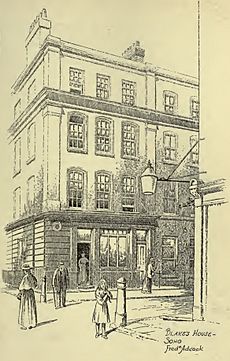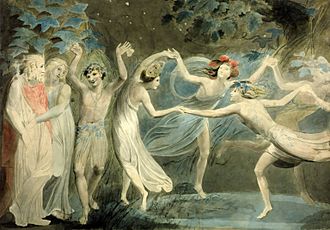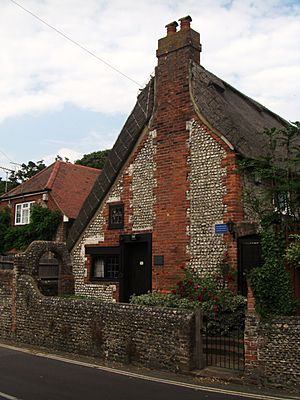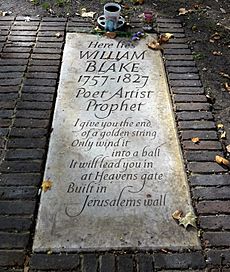William Blake facts for kids
Quick facts for kids
William Blake
|
|
|---|---|
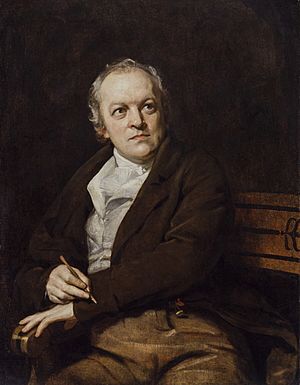
Portrait by Thomas Phillips (1807)
|
|
| Born | 28 November 1757 Soho, London |
| Died | 12 August 1827 (aged 69) Charing Cross, London |
| Occupation |
|
| Education | Royal Academy of Arts |
| Genre | Poetry |
| Literary movement | Romanticism |
| Notable works | Songs of Innocence and of Experience, The Marriage of Heaven and Hell, The Four Zoas, Jerusalem, Milton |
| Spouse |
Catherine Boucher
(m. 1782) |
| Signature | |
William Blake (28 November 1757 – 12 August 1827) was an English poet, painter, and printmaker. In 2002, Blake was placed at number 38 in the BBC's poll of the 100 Greatest Britons.
Contents
Early life

William Blake was born on 28 November 1757 at 28 Broad Street (now Broadwick St.) in Soho, London. He was the third of seven children, two of whom died in infancy. Blake's father, James, was a hosier, who had lived in London. He attended school only long enough to learn reading and writing, leaving at the age of ten, and was otherwise educated at home by his mother Catherine Blake (née Wright). Even though the Blakes were English Dissenters, William was baptised on 11 December at St James's Church, Piccadilly, London. The Bible was an early and profound influence on Blake, and remained a source of inspiration throughout his life. Blake's childhood, according to him, included mystical religious experiences such as "beholding God's face pressed against his window, seeing angels among the haystacks, and being visited by the Old Testament prophet Ezekiel."
Blake started engraving copies of drawings of Greek antiquities purchased for him by his father, a practice that was preferred to actual drawing. Within these drawings Blake found his first exposure to classical forms through the work of Raphael, Michelangelo, Maarten van Heemskerck and Albrecht Dürer. The number of prints and bound books that James and Catherine were able to purchase for young William suggests that the Blakes enjoyed, at least for a time, a comfortable wealth. When William was ten years old, his parents knew enough of his headstrong temperament that he was not sent to school but instead enrolled in drawing classes at Henry Pars' drawing school in the Strand. He read avidly on subjects of his own choosing. During this period, Blake made explorations into poetry; his early work displays knowledge of Ben Jonson, Edmund Spenser, and the Psalms.
Apprenticeship
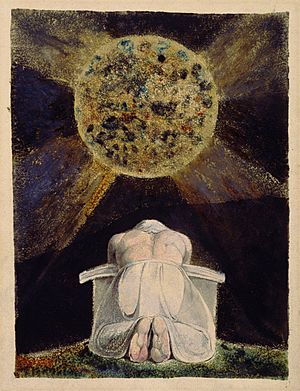
On 4 August 1772, Blake was apprenticed to engraver James Basire of Great Queen Street, at the sum of £52.10, for a term of seven years. At the end of the term, aged 21, he became a professional engraver. No record survives of any serious disagreement or conflict between the two during the period of Blake's apprenticeship, but Peter Ackroyd's biography notes that Blake later added Basire's name to a list of artistic adversaries; and then crossed it out. This aside, Basire's style of line-engraving was of a kind held at the time to be old-fashioned compared to the flashier stipple or mezzotint styles. It has been speculated that Blake's instruction in this outmoded form may have been detrimental to his acquiring of work or recognition in later life.
After two years, Basire sent his apprentice to copy images from the Gothic churches in London (perhaps to settle a quarrel between Blake and James Parker, his fellow apprentice). His experiences in Westminster Abbey helped form his artistic style and ideas.
Royal Academy
On 8 October 1779, Blake became a student at the Royal Academy in Old Somerset House, near the Strand. While the terms of his study required no payment, he was expected to supply his own materials throughout the six-year period. There, he rebelled against what he regarded as the unfinished style of fashionable painters such as Rubens, championed by the school's first president, Joshua Reynolds. Over time, Blake came to detest Reynolds' attitude towards art and preferred the Classical precision of his early influences, Michelangelo and Raphael.
Marriage
In 1781 Blake met Catherine Boucher, five years his junior. They married on 18 August 1782 in St Mary's Church, Battersea. Illiterate, Catherine signed her wedding contract with an X. The original wedding certificate may be viewed at the church, where a commemorative stained-glass window was installed between 1976 and 1982.
Later, in addition to teaching Catherine to read and write, Blake trained her as an engraver. Throughout his life she proved a valuable aid, helping to print his illuminated works and maintaining his spirits throughout numerous misfortunes.
Career
Around 1783, Blake's first collection of poems, Poetical Sketches, was printed.
In 1784, after his father's death, Blake and former fellow apprentice James Parker opened a print shop. They began working with radical publisher Joseph Johnson. Johnson's house was a meeting-place for some leading English intellectual dissidents of the time: theologian and scientist Joseph Priestley; philosopher Richard Price; artist John Henry Fuseli; early feminist Mary Wollstonecraft; and English-American revolutionary Thomas Paine. Along with William Wordsworth and William Godwin, Blake had great hopes for the French and American revolutions and wore a Phrygian cap in solidarity with the French revolutionaries, but despaired with the rise of Robespierre and the Reign of Terror in France. That same year, Blake composed his unfinished manuscript An Island in the Moon (1784).
Blake illustrated Original Stories from Real Life (2nd edition, 1791) by Mary Wollstonecraft.
From 1790 to 1800, William Blake lived in North Lambeth, London, at 13 Hercules Buildings, Hercules Road. The property was demolished in 1918, but the site is now marked with a plaque. A series of 70 mosaics commemorates Blake in the nearby railway tunnels of Waterloo Station. The mosaics largely reproduce illustrations from Blake's illuminated books, The Songs of Innocence and of Experience, The Marriage of Heaven and Hell, and the prophetic books.
Relief etching
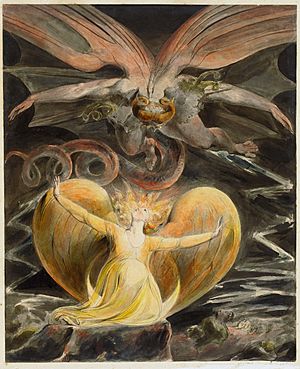
In 1788, aged 31, Blake experimented with relief etching, a method he used to produce most of his books, paintings, pamphlets and poems. The process is also referred to as illuminated printing, and the finished products as illuminated books or prints. Illuminated printing involved writing the text of the poems on copper plates with pens and brushes, using an acid-resistant medium. Illustrations could appear alongside words in the manner of earlier illuminated manuscripts. He then etched the plates in acid to dissolve the untreated copper and leave the design standing in relief (hence the name).
This is a reversal of the usual method of etching, where the lines of the design are exposed to the acid, and the plate printed by the intaglio method. Relief etching (which Blake referred to as "stereotype" in The Ghost of Abel) was intended as a means for producing his illuminated books more quickly than via intaglio. Stereotype, a process invented in 1725, consisted of making a metal cast from a wood engraving, but Blake's innovation was, as described above, very different. The pages printed from these plates were hand-coloured in watercolours and stitched together to form a volume. Blake used illuminated printing for most of his well-known works, including Songs of Innocence and of Experience, The Book of Thel, The Marriage of Heaven and Hell and Jerusalem.
Engravings
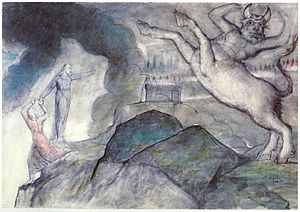
Although Blake has become better known for his relief etching, his commercial work largely consisted of intaglio engraving, the standard process of engraving in the 18th century in which the artist incised an image into the copper plate, a complex and laborious process, with plates taking months or years to complete, but as Blake's contemporary, John Boydell, realised, such engraving offered a "missing link with commerce", enabling artists to connect with a mass audience and became an immensely important activity by the end of the 18th century.
Europe Supported by Africa and America is an engraving by Blake held in the collection of the University of Arizona Museum of Art. The engraving was for a book written by Blake's friend John Gabriel Stedman called The Narrative of a Five Years Expedition against the Revolted Negroes of Surinam (1796). It depicts three women embracing one another. Black Africa and White Europe hold hands in a gesture of equality, as the barren earth blooms beneath their feet. Europe wears a string of pearls, while her sisters Africa and America are depicted wearing slave bracelets. Some scholars have speculated that the bracelets represent the "historical fact" of slavery in Africa and the Americas while the handclasp refer to Stedman's "ardent wish": "we only differ in color, but are certainly all created by the same Hand." Others have said it "expresses the climate of opinion in which the questions of color and slavery were, at that time, being considered, and which Blake's writings reflect".
Blake employed intaglio engraving in his own work, such as for his Illustrations of the Book of Job, completed just before his death. Most critical work has concentrated on Blake's relief etching as a technique because it is the most innovative aspect of his art, but a 2009 study drew attention to Blake's surviving plates, including those for the Book of Job: they demonstrate that he made frequent use of a technique known as "repoussage", a means of obliterating mistakes by hammering them out by hitting the back of the plate. Such techniques, typical of engraving work of the time, are very different from the much faster and fluid way of drawing on a plate that Blake employed for his relief etching, and indicates why the engravings took so long to complete.
Later life
Blake's marriage to Catherine was close and devoted until his death. Blake taught Catherine to write, and she helped him colour his printed poems.
Blake returned to London in 1804 and began to write and illustrate Jerusalem (1804–20), his most ambitious work.
In later life Blake began to sell a great number of his works, particularly his Bible illustrations, to Thomas Butts, a patron who saw Blake more as a friend than a man whose work held artistic merit; this was typical of the opinions held of Blake throughout his life.
The commission for Dante's Divine Comedy came to Blake in 1826 through Linnell, with the aim of producing a series of engravings. Blake's death in 1827 cut short the enterprise, and only a handful of watercolours were completed, with only seven of the engravings arriving at proof form. Even so, they have earned praise:
[T]he Dante watercolours are among Blake's richest achievements, engaging fully with the problem of illustrating a poem of this complexity. The mastery of watercolour has reached an even higher level than before, and is used to extraordinary effect in differentiating the atmosphere of the three states of being in the poem.
Blake's illustrations of the poem are not merely accompanying works, but rather seem to critically revise, or furnish commentary on, certain spiritual or moral aspects of the text.
Final years

Blake's last years were spent at Fountain Court off the Strand (the property was demolished in the 1880s, when the Savoy Hotel was built). On the day of his death (12 August 1827), Blake worked relentlessly on his Dante series. Eventually, it is reported, he ceased working and turned to his wife, who was in tears by his bedside. Beholding her, Blake is said to have cried, "Stay Kate! Keep just as you are – I will draw your portrait – for you have ever been an angel to me." Having completed this portrait (now lost), Blake laid down his tools and began to sing hymns and verses. At six that evening, after promising his wife that he would be with her always, Blake died. George Richmond gives the following account of Blake's death in a letter to Samuel Palmer:
Blake was buried in a plot shared with others, five days after his death – on the eve of his 45th wedding anniversary – at the Dissenter's burial ground in Bunhill Fields, in what is today the London Borough of Islington. His parents' bodies were buried in the same graveyard. Present at the ceremonies were Catherine, Edward Calvert, George Richmond, Frederick Tatham and John Linnell. Following Blake's death, Catherine moved into Tatham's house as a housekeeper. She believed she was regularly visited by Blake's spirit. She continued selling his illuminated works and paintings, but entertained no business transaction without first "consulting Mr. Blake". On the day of her death, in October 1831, she was as calm and cheerful as her husband.
Blake's grave is commemorated by two stones. The first was a stone that reads "Near by lie the remains of the poet-painter William Blake 1757–1827 and his wife Catherine Sophia 1762–1831". The memorial stone is situated approximately 20 metres (66 ft) away from the actual grave, which was not marked until 12 August 2018. For years since 1965, the exact location of William Blake's grave had been lost and forgotten. The area had been damaged in the Second World War; gravestones were removed and a garden was created. The memorial stone, indicating that the burial sites are "nearby", was listed as a Grade II listed structure in 2011. A Portuguese couple, Carol and Luís Garrido, rediscovered the exact burial location after 14 years of investigatory work, and the Blake Society organised a permanent memorial slab, which was unveiled at a public ceremony at the site on 12 August 2018. The new stone is inscribed "Here lies William Blake 1757–1827 Poet Artist Prophet" above a verse from his poem Jerusalem.
The Blake Prize for Religious Art was established in his honour in Australia in 1949. In 1957 a memorial to Blake and his wife was erected in Westminster Abbey. Another memorial lies in St James's Church, Piccadilly, where he was baptised.
At the time of Blake's death, he had sold fewer than 30 copies of Songs of Innocence and of Experience.
Exhibitions
Major recent exhibitions focusing on William Blake include:
- The Ashmolean Museum's (Oxford) exhibition William Blake: Apprentice and Master, open from December 2014 until March 2015, examined William Blake's formation as an artist, as well as his influence on young artist-printmakers who gathered around him in the last years of his life.
- The National Gallery of Victoria's exhibition William Blake in summer 2014 showcased the Gallery's collection of works by William Blake which includes spectacular watercolours, single prints and illustrated books.
- The Morgan Library & Museum exhibition William Blake's World: A New Heaven Is Begun, open from September 2009 until January 2010, included more than 100 watercolours, prints, and illuminated books of poetry.
- An exhibition at Tate Britain in 2007–2008, William Blake, coincided with the two hundred and fiftieth anniversary of William Blake's birth and included Blake works from the Gallery's permanent collection, but also private loans of recently discovered works which had never before been exhibited.
- The Scottish National Gallery 2007 exhibition William Blake coincided with the two hundred and fiftieth anniversary of William Blake's birth and featured all of the Gallery's works associated with Blake.
- An exhibition at Tate Britain in 2000–2001, William Blake, displayed the full range of William Blake's art and poetry, together with contextual materials, arranged in four sections: One of the Gothic Artists; The Furnace of Lambeth's Vale; Chambers of the Imagination; Many Formidable Works.
- In 2016 the world's first William Blake antique bookstore and art gallery opened in San Francisco, US.
- A major exhibition on Blake at Tate Britain in London opened in the autumn of 2019.
Images for kids
-
Blake's Ancient of Days. The "Ancient of Days" is described in Chapter 7 of the Book of Daniel. This image depicts Copy D of the illustration currently held at the British Museum.
-
The Ghost of a Flea, 1819–1820. Having informed painter-astrologer John Varley of his visions of apparitions, Blake was subsequently persuaded to paint one of them. Varley's anecdote of Blake and his vision of the flea's ghost became well-known.
-
Memorial marking Blake's birthplace in Soho, City of Westminster.
-
A memorial to William Blake in St James's Church, Piccadilly
See also
 In Spanish: William Blake para niños
In Spanish: William Blake para niños


